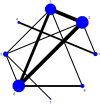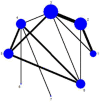Efficacy of Acupuncture-Related Therapy in the Treatment of Knee Osteoarthritis: A Network Meta-Analysis of Randomized Controlled Trials
- PMID: 34321920
- PMCID: PMC8302815
- DOI: 10.2147/JPR.S315956
Efficacy of Acupuncture-Related Therapy in the Treatment of Knee Osteoarthritis: A Network Meta-Analysis of Randomized Controlled Trials
Abstract
Objective: Knee osteoarthritis (KOA) is prevalent in middle-aged and elderly people. This condition negatively affects the quality of life of patients. Although non-steroidal anti-inflammatory drugs (NSAIDs) are often used to relieve symptoms associated with KOA, it is associated with many side effects. Acupuncture and moxibustion therapies have been applied in the treatment of KOA. However, the efficacy of various acupuncture and moxibustion treatments has not been compared.
Methods: Randomized controlled trials (RCTs) on the application of acupuncture and moxibustion in the treatment of KOA were searched in English databases and Chinese databases. Data were retrieved from establishment of the database to September 2020. Data analysis was performed using Stata14.0 and GeMTC 0.14.3 softwares.
Results: A total of 40 RCTs involving 3215 patients with KOA were retrieved. Network meta-analysis revealed that the fire needle was superior to western medicine, electro-acupuncture, conventional acupuncture, warm needle and sham acupuncture; warm needle was better than conventional acupuncture and western medicine whereas electro-acupuncture was better than conventional acupuncture in improving pain scores in the Western Ontario and McMaster Universities Osteoarthritis Index (WOMAC). Moreover, we found that fire needle and warm needle more effectively improved WOMAC stiffness scores than western medicine and sham moxibustion, whereas electro-acupuncture was superior to western medicine and sham moxibustion in improving WOMAC stiffness scores. Further analysis revealed that fire needle, warm needle and electro-acupuncture were more effective in improving WOMAC joint function scores than conventional acupuncture and western medicine. The fire needle was superior to conventional acupuncture and sham acupuncture, whereas electro-acupuncture was better than western medicine, conventional acupuncture and sham acupuncture in improving visual analogue scale scores.
Conclusion: This study shows that fire needle is superior to warm needle and electro-acupuncture, whereas warm needle and electro-acupuncture are better than conventional acupuncture, western medicine, sham moxibustion and sham acupuncture.
Keywords: acupuncture; knee osteoarthritis; moxibustion; network meta-analysis; randomized controlled trials.
© 2021 Liu et al.
Conflict of interest statement
The authors report no conflicts of interest in this work.
Figures







Similar articles
-
The efficacy of acupuncture therapies in cervical spondylotic radiculopathy: A network meta-analysis.Heliyon. 2024 May 27;10(11):e31793. doi: 10.1016/j.heliyon.2024.e31793. eCollection 2024 Jun 15. Heliyon. 2024. PMID: 38912448 Free PMC article. Review.
-
Efficacy of Different Acupuncture Techniques for Pain and Dysfunction in Patients with Knee Osteoarthritis: A Randomized Controlled Trial.Pain Ther. 2025 Apr;14(2):737-751. doi: 10.1007/s40122-025-00713-x. Epub 2025 Feb 17. Pain Ther. 2025. PMID: 39961986 Free PMC article.
-
Different kinds of acupuncture treatments for knee osteoarthritis: a multicentre, randomized controlled trial.Trials. 2020 Mar 14;21(1):264. doi: 10.1186/s13063-019-4034-8. Trials. 2020. PMID: 32171318 Free PMC article.
-
The Effectiveness and Safety of Moxibustion for Treating Knee Osteoarthritis: A PRISMA Compliant Systematic Review and Meta-Analysis of Randomized Controlled Trials.Pain Res Manag. 2019 Dec 17;2019:2653792. doi: 10.1155/2019/2653792. eCollection 2019. Pain Res Manag. 2019. PMID: 31949547 Free PMC article.
-
Effectiveness and safety of fire needle for knee osteoarthritis: A protocol of systematic review and meta-analysis.Medicine (Baltimore). 2021 Jan 22;100(3):e23962. doi: 10.1097/MD.0000000000023962. Medicine (Baltimore). 2021. PMID: 33545978 Free PMC article.
Cited by
-
Effect of Acupuncture on the Cognitive Control Network of Patients with Knee Osteoarthritis: Study Protocol for a Randomized Controlled Trial.J Pain Res. 2022 May 18;15:1443-1455. doi: 10.2147/JPR.S356044. eCollection 2022. J Pain Res. 2022. PMID: 35611301 Free PMC article.
-
Optimal acupuncture protocol improving symptoms of typical dry eye syndrome: meta-analysis and systematic review.Heliyon. 2023 Jul 13;9(7):e18226. doi: 10.1016/j.heliyon.2023.e18226. eCollection 2023 Jul. Heliyon. 2023. PMID: 37539212 Free PMC article.
-
Acupuncture for the Treatment of Knee Osteoarthritis: An Overview of Systematic Reviews.Int J Gen Med. 2021 Nov 19;14:8481-8494. doi: 10.2147/IJGM.S342435. eCollection 2021. Int J Gen Med. 2021. PMID: 34848997 Free PMC article. Review.
-
Therapeutic Effects of Fire Needling Acupuncture on Pain Relief and Cartilage Protection in MIA-Induced Knee Osteoarthritis Rats: The Role of Macrophage Polarization in Synovium and Angiogenesis in Subchondral Bone.J Inflamm Res. 2025 Jun 9;18:7459-7475. doi: 10.2147/JIR.S518829. eCollection 2025. J Inflamm Res. 2025. PMID: 40519654 Free PMC article.
-
Effectiveness and Safety of Acupuncture-Related Therapies for Chronic Musculoskeletal Pain: A Protocol for Systematic Review and Network Meta-Analysis.J Pain Res. 2022 Dec 16;15:3959-3969. doi: 10.2147/JPR.S387756. eCollection 2022. J Pain Res. 2022. PMID: 36561644 Free PMC article.
References
-
- Palmer KT, Reading I, Calnan M, Linaker C, Coggon D, Palmer KT, Reading I, Calnan M, et al. Does knee pain in the community behave like a regional pain syndrome? Prospective cohort study of incidence and persistence. Ann Rheum Dis. 2007;66(9):1190–1194. doi:10.1136/ard.2006.061481 - DOI - PMC - PubMed
-
- Lu YH, Shi XB. Current status and progress of epidemiological studies on knee osteoarthritis. Chine J Traditional Med Traumatology Orthopedics. 2012;20(6):81–84.
Publication types
LinkOut - more resources
Full Text Sources

